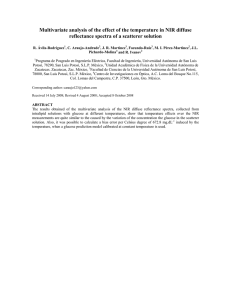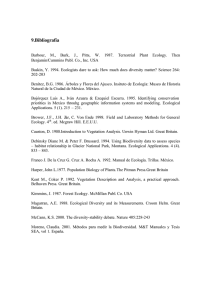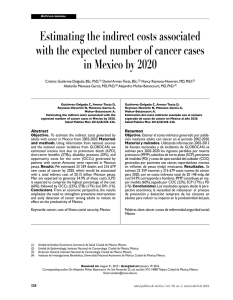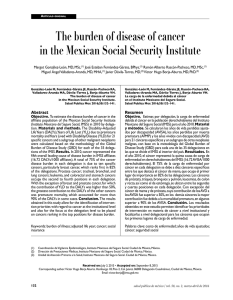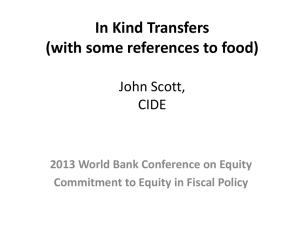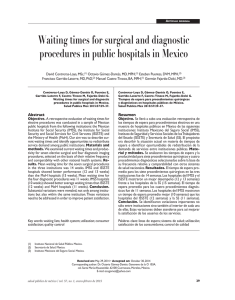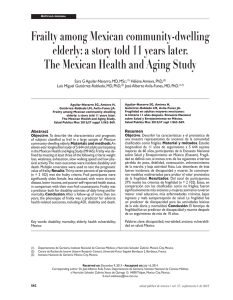Referencias Causes of total and permanent disability in
Anuncio
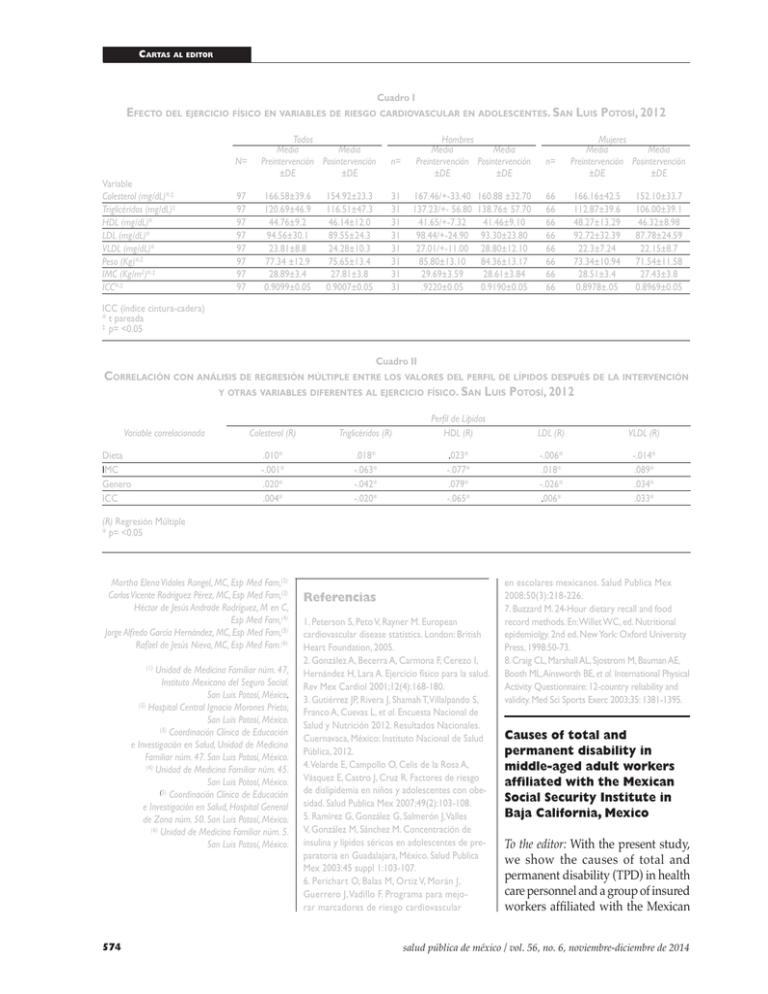
Cartas al editor Cuadro I Efecto del ejercicio físico en variables de riesgo cardiovascular en adolescentes. San Luis Potosí, 2012 Variable Colesterol (mg/dL)*,‡ Triglicéridos (mg/dL)‡ HDL (mg/dL)* LDL (mg/dL)* VLDL (mg/dL)* Peso (Kg)*,‡ IMC (Kg/m2)*,‡ ICC*,‡ N= Todos Media Media Preintervención Posintervención ±DE ±DE n= 97 97 97 97 97 97 97 97 166.58±39.6 120.69±46.9 44.76±9.2 94.56±30.1 23.81±8.8 77.34 ±12.9 28.89±3.4 0.9099±0.05 31 31 31 31 31 31 31 31 154.92±23.3 116.51±47.3 46.14±12.0 89.55±24.3 24.28±10.3 75.65±13.4 27.81±3.8 0.9007±0.05 Hombres Media Media Preintervención Posintervención ±DE ±DE 167.46/+-33.40 137.23/+- 56.80 41.65/+-7.32 98.44/+-24.90 27.01/+-11.00 85.80±13.10 29.69±3.59 .9220±0.05 160.88 ±32.70 138.76± 57.70 41.46±9.10 93.30±23.80 28.80±12.10 84.36±13.17 28.61±3.84 0.9190±0.05 n= Mujeres Media Media Preintervención Posintervención ±DE ±DE 66 66 66 66 66 66 66 66 166.16±42.5 112.87±39.6 48.27±13.29 92.72±32.39 22.3±7.24 73.34±10.94 28.51±3.4 0.8978±.05 152.10±33.7 106.00±39.1 46.32±8.98 87.78±24.59 22.15±8.7 71.54±11.58 27.43±3.8 0.8969±0.05 ICC (índice cintura-cadera) * t pareada ‡ p= <0.05 Cuadro II Correlación con análisis de regresión múltiple entre los valores del perfil de lípidos después de la intervención y otras variables diferentes al ejercicio físico. San Luis Potosí, 2012 Variable correlacionada Dieta IMC Genero ICC Colesterol (R) Triglicéridos (R) Perfil de Lípidos HDL (R) LDL (R) VLDL (R) .010* -.001* .020* .004* .018* -.063* -.042* -.020* .023* -.077* .079* -.065* -.006* .018* -.026* .006* -.014* .089* .034* .033* (R) Regresión Múltiple * p= <0.05 Martha Elena Vidales Rangel, MC, Esp Med Fam,(2) Carlos Vicente Rodríguez Pérez, MC, Esp Med Fam,(3) Héctor de Jesús Andrade Rodríguez, M en C, Esp Med Fam,(4) Jorge Alfredo García Hernández, MC, Esp Med Fam,(5) Rafael de Jesús Nieva, MC, Esp Med Fam.(6) (1) Unidad de Medicina Familiar núm. 47, Instituto Mexicano del Seguro Social. San Luis Potosí, México. (2) Hospital Central Ignacio Morones Prieto, San Luis Potosí, México. (3) Coordinación Clínica de Educación e Investigación en Salud, Unidad de Medicina Familiar núm. 47. San Luis Potosí, México. (4) Unidad de Medicina Familiar núm. 45. San Luis Potosí, México. (5) Coordinación Clínica de Educación e Investigación en Salud, Hospital General de Zona núm. 50. San Luis Potosí, México. (6) Unidad de Medicina Familiar núm. 5. San Luis Potosí, México. 574 Referencias 1. Peterson S, Peto V, Rayner M. European cardiovascular disease statistics. London: British Heart Foundation, 2005. 2. González A, Becerra A, Carmona F, Cerezo I, Hernández H, Lara A. Ejercicio físico para la salud. Rev Mex Cardiol 2001;12(4):168-180. 3. Gutiérrez JP, Rivera J, Shamah T,Villalpando S, Franco A, Cuevas L, et al. Encuesta Nacional de Salud y Nutrición 2012. Resultados Nacionales. Cuernavaca, México: Instituto Nacional de Salud Pública, 2012. 4.Velarde E, Campollo O, Celis de la Rosa A, Vásquez E, Castro J, Cruz R. Factores de riesgo de dislipidemia en niños y adolescentes con obesidad. Salud Publica Mex 2007;49(2):103-108. 5. Ramírez G, González G, Salmerón J,Valles V, González M, Sánchez M. Concentración de insulina y lípidos séricos en adolescentes de preparatoria en Guadalajara, México. Salud Publica Mex 2003:45 suppl 1:103-107. 6. Perichart O, Balas M, Ortiz V, Morán J, Guerrero J, Vadillo F. Programa para mejorar marcadores de riesgo cardiovascular en escolares mexicanos. Salud Publica Mex 2008;50(3):218-226. 7. Buzzard M. 24-Hour dietary recall and food record methods. En:Willet WC, ed. Nutritional epidemiolgy. 2nd ed. New York: Oxford University Press, 1998:50-73. 8. Craig CL, Marshall AL, Sjostrom M, Bauman AE, Booth ML, Ainsworth BE, et al. International Physical Activity Questionnaire: 12-country reliability and validity. Med Sci Sports Exerc 2003;35: 1381-1395. Causes of total and permanent disability in middle-aged adult workers affiliated with the Mexican Social Security Institute in Baja California, Mexico To the editor: With the present study, we show the causes of total and permanent disability (TPD) in health care personnel and a group of insured workers affiliated with the Mexican salud pública de méxico / vol. 56, no. 6, noviembre-diciembre de 2014 Cartas al editor Social Security Institute (IMSS) in the state of Baja California, Mexico, dur­ ing the period from 2005 to 2011. Worldwide, pensions usually only refer to retirement pensions. However, another important real­ ity that accompanies any pension system is that not all members reach retirement in an optimal state of health. Disease and non-occupational accidents causing disability are also important in the scheme of social security.1 According to Article 119 of the IMSS' Law, TPD exists when the insured person suffers a total disabil­ ity that results in a 50% loss of regular monthly income and that inability results from a non-professional ill­ ness or accident.2 We included all (n= 208) cases of TPD reported in IMSS health care personnel issued from January 1, 2005 to December 31, 2011. The causes of disability among health care personnel were matched in a 2:1 ratio with the first 416 TPD reports of workers insured with the IMSS by gender and age (±5 years). The average age (±SD) at the time of the disability report was 47.0 (±7.0) years and 379 (60.7%) were women. The main causes of disability are shown in table I. Females had a significantly higher frequency of disability for rheumatic diseases (13.2 vs. 6.5%, p=0.008). Males had a significantly higher frequency of disability due to secondary to chronic diabetes mel­ litus (DM) (16.7 vs. 11.1%, p=0.04), cardiovascular diseases (20.0 vs. 9.5%, p=0.001) and psychiatric dis­ orders (7.8 vs. 4.5%, p=0.08) (table II). The Global Burden of Disease (GBD) studies done in 2010 found the main contributors to global years lived with disability (YLD) were mental and behavioral disorders, musculoskeletal disorders, and diabetes.3 The number of people with disabilities is increasing due to popu­ lation growth, ageing, emergence of chronic diseases and medical ad­ Table I Disability causes in health personnel and in persons insured by the IMSS. Mexico, 2005-2011 Disorders n= 624 % Kidney Neurological Hemato-oncological Rheumatic diseases Cardiovascular Ophthalmological Gastrointestinal Respiratory Musculoskeletal Psychiatric disorders Cervical/lumbar spine herniated disk Disability due to diabetes mellitus chronic complications 21 3.4 53 8.5 72 11.5 66 10.6 85 13.6 30 4.8 32 5.1 25 4.0 44 7.1 36 5.8) 77 12.3 83 13.3 vances that preserve and prolong life, creating overwhelming demands for health and rehabilitation services. Diabetes, hypercholesterolemia, systemic arterial hypertension, smok­ ing and obesity are considered to be traditional risk factors for cardio­ vascular disease (CVD). In Mexico, a high prevalence of CVD risk fac­ tors has been observed in the adult Mexican population, which could explain the higher frequency of total disability from CVD diseases and diabetes seen in our study. In Mexico, 9% have type 2 DM4 and 13% of the population (<40 years of age) have early-onset of type 2 DM.5 In our study, DM was one of the major causes of disability. Diabetes increases the risk of disabling and life-threatening complications due to microvascular disease (affecting the kidneys, eyes and limbs) and macrovascular disease (involving the coronary, cerebrovascular and peripheral vascular systems). It is essential to maintain inte­ grated preventive health programs for the entire population with the aim of identifying health risk factors in a timely manner, thus avoiding complications that are ultimately responsible for some disabling condi­ tions. Abraham Zonana-Nacach, MC,(1) [email protected] Alejandra Acosta-Angulo, MC,(2) Marco César Moreno-Cázarez, MC,(3) Rafael Gómez-Naranjo, MC.(4) (1) Unidad de Investigación Clínica y Epidemiológica, Hospital General Regional No. 20, Instituto Mexicano del Seguro Social.Tijuana, Baja California, México. (2) Unidad de Medicina Familiar No. 27, Instituto Mexicano del Seguro Social.Tijuana, Baja California, México. (3) Servicio de Prevención y Promoción de la Salud para los Trabajadores del IMSS, HGR No. 20, Instituto Mexicano del Seguro Social.Tijuana, Baja California, México. (4) Programa Salud en el Trabajo, HGR No. 20, Instituto Mexicano del Seguro Social.Tijuana, Baja California, México. Table II Disability causes in health personnel and in persons insured by the IMSS, by gender. Mexico, 2005-2011 Disorders, n (%) Cardiovascular diseases Disability due to diabetes mellitus chronic complications Cervical/lumbar spine herniated disk Rheumatic diseases Neurologic diseases Psychiatric disorders Musculoskeletal salud pública de méxico / vol. 56, no. 6, noviembre-diciembre de 2014 Female n= 379 Gender Male n=245 p 36 (9.5) 42 (11.1) 53 (14.0) 50 (13.2) 31 (8.2) 17 (4.5) 28 (7.4) 49 (20.0) 41 (16.7) 24 (9.8) 16 (6.5) 22 (9.0) 19 (7.8) 16 (6.5) 0.0001 0.004 0.12 0.008 0.72 0.08 0.69 575 Cartas al editor References 1. The International Labour Organization (ILO). The Social Security (minimum standards) Convention, 1952 (No. 102) [internet document]. Aviable at: http://www.ilo.org/dyn/normlex/ en/f?p=1000:1:0::NO::: 2. Ley del Seguro Social. Capítulo V del seguro de invalidez y vida, IMSS [internet document]. Aviable at: www.imss.gob.mx/estadisticas/ Documents/20112012/C05.pdf. 3. Vos T, Flaxman AD, Naghavi M, Lozano R, Michaud C, Ezzati M, et al.���������������������� Years lived with disability (YLDs) for 1160 sequelae of 289 diseases and injuries 1990-2010: a systematic analysis for the Global Burden of Disease Study 2010. Lancet 2012;380(9859):2163-2196. 4. Escobedo-de la Peña J, Buitrón-Granados LV, Ramírez-Martínez JC, Chavira-Mejía R, Schargrodsky H, Champagne BM. Diabetes in Mexico. CARMELA study. Cir Cir 2011;79:424-431. 5. Jiménez-Corona A, Rojas R, Gómez-Pérez FJ, Aguilar-Salinas CA. Early-onset type 2 diabetes in a Mexican survey: results from the National Health and Nutrition Survey 2006. Salud Publica Mex 2010;52 suppl 1:S27-S35. Association between perceived mental stress and physical activity in elderly Korean people To the editor: Korea has experienced rapid socio-economic growth over the past several decades and also one of the highest growth rates in the world. The proportion of the elderly popula­ tion aged over 65 years will increase dramatically from 7.2% in 2000 to 20.8% in 2020. The growth of the elderly population in Korean society threatens its national health.1 Higher levels of stress can lead to a series of negative consequences such as depression and suicide.2 Physically active people are not only less sensitive to negative influences of daily stress, but are also less responsive to physical stress.3 Among stress-coping activities, physical activity (PA) has been shown to be beneficial to both physical and mental health and has been regarded as an effective method to prevent stressrelated diseases.4 Thus, helping elderly people who do not have established 576 patterns of PA to acquire healthy habits for increasing PA is useful in terms of public health. This study used national data from the fifth Korea National Health and Nutrition Survey (KNHANES-V) in 2010 and 2011 to investigate whether the level of PA is associated with perceived mental stress (PMS) status in elderly Korean people. KNHANES-V was conducted using a systematic stratified cluster sampling design. 2 837 elderly people aged over 65 years were selected for this study sample. Participants were asked to rate their PMS status as very high, high, low, and none. Questions of PA in­ formation were compared with the guidelines of the American College of Sports Medicine. 5 Information regarding the gender, age, educa­ tion, family socio-economic status, and marital status of each participant was collected as confounding factors during interviews. Males show higher levels of edu­ cation, family socio-economic status, married status, and positive PMS status compared to females. Partici­ pation ratios of vigorous, moderate, and low PA significantly declined with age in both males and females (table I). The crude odds ratios (COR) Table I Characteristics of elderly Korean people Males (n= 1 233) Characteristics Females (n= 1 604) Total (n= 2 837) X2 value p value Age (years) 65-74 75-84 85 ≤ 863 (70.0) 340 (27.6) 30 ( 2.4) 1 060 (66.1) 491 (30.6) 53 ( 3.3) 1 923 (67.8) 831 (29.3) 83 ( 2.9) 5.572 .062 Education < elementary school Elementary school Middle school High school ≤ 582 (47.2) 205 (16.6) 284 (23.0) 162 (13.1) 1 342 (83.6) 127 ( 7.9) 116 ( 7.3) 19 ( 1.2) 1 924 (67.8) 459.276 332 (11.7) 400 (14.1) 181 ( 6.4) <.001 Family socio-economic status Low Average Middle high High 594 (48.6) 330 (27.0) 170 (13.9) 127 (10.4) 891 (56.4) 336 (21.3) 192 (12.2) 160 (10.1) 1 485 (53.0) 666 (23.6) 362 (12.9) 287 (10.3) 19.125 <.001 1 121 (90.9) 7 ( 0.6) 87 ( 7.1) 18 ( 1.5) 779 (48.6) 13 ( 0.8) 782 (48.7) 30 (1.9) 1 900 (67.0) 590.916 20 ( 0.7) 869 (30.6) 48 ( 1.7) <.001 Perceived mental stress Very high High Low None 22 ( 1.8) 141 (11.4) 642 (52.1) 428 (34.7) 84 ( 5.2) 373 (23.3) 685 (42.7) 462 (28.8) 106 ( 3.8) 514 (18.1) 1 327 (46.8 890 (31.4) 89.423 <.001 Physical activity participation Vigorous activity* Moderate activity‡ Low activity§ 181 (14.7) 166 (13.7) 952 (77.2) 168 (10.8) 372 (23.2) 1 021 (63.7) 349 (12.3) 538 (19.0) 1 973 (70.0) 75.013 <.001 Marital status Married Separated Widowed Divorced Data is presented as n (%) 20 minutes vigorous physical activity ≥ three times/week 30 minutes moderate physical activity ≥ five times/week § 30 minutes walking ≥ five times/week * ‡ salud pública de méxico / vol. 56, no. 6, noviembre-diciembre de 2014
